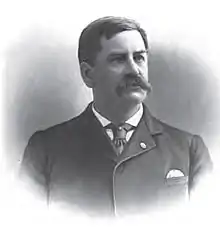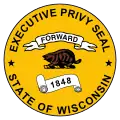William H. Upham
William Henry Upham (May 3, 1841 – July 2, 1924) was an American soldier, businessman, and politician who served as the 18th Governor of Wisconsin.[1]
William H. Upham | |
|---|---|
 | |
| 18th Governor of Wisconsin | |
| In office January 7, 1895 – January 4, 1897 | |
| Lieutenant | Emil Baensch |
| Preceded by | George Wilbur Peck |
| Succeeded by | Edward Scofield |
| 3rd and 6th Mayor of Marshfield, Wisconsin | |
| In office April 1891 – April 1892 | |
| Preceded by | L. A. Arnold |
| Succeeded by | Henry Kalsched |
| In office April 1886 – April 1888 | |
| Preceded by | W. H. Budge |
| Succeeded by | Adam Hafer |
| Member of the Marshfield City Council | |
| In office April 1883 – April 1886 | |
| Personal details | |
| Born | William Henry Upham May 3, 1841 Westminster, Massachusetts |
| Died | July 2, 1924 (aged 83) Marshfield, Wisconsin |
| Resting place | Hillside Cemetery, Marshfield, Wisconsin |
| Political party | Republican |
| Spouse(s) |
|
| Children | 3 |
| Signature | |
| Military service | |
| Allegiance | |
| Branch/service | Union Army |
| Years of service |
|
| Rank | |
| Unit | |
| Battles/wars | American Civil War |
Biography
Upham was born in Westminster, Massachusetts,[2] and moved to Niles, Michigan around 1852 and then Kenosha, Wisconsin, in 1853.[2] He graduated from Racine High School in Racine, Wisconsin, the first public school in Wisconsin.[3][4]
Military service
At the outbreak of the American Civil War, he enlisted in the Union Army (United States Volunteers) and served in Company F of the 2nd Wisconsin Volunteer Infantry Regiment, called the Belle City Rifles. Shortly after its creation, the 2nd Wisconsin—along with the 6th Wisconsin, 7th Wisconsin, and 19th Indiana Volunteer Infantry Regiments—was organized into the unit later known as the "Iron Brigade" in the Army of the Potomac.
He was wounded during the First Battle of Bull Run by a bullet passing through his shoulder strap that supported his cartridge box just at the shoulder blade. After going to the field hospital, he was captured by Confederate forces and sent to the converted tobacco barn, Libby Prison, along with other members of his company—F. Lacy, James Anderson, John H. Anderson, and Antle Henry. Congressman Alfred Ely from New York was captured along with them.
At Libby Prison, he was attended by Dr. Lewis, the 2nd Wisconsin's surgeon. His family in Wisconsin, however, was told that he had been killed in action and held a funeral for him in Racine, Wisconsin—the captain of his company, William E. Strong, had seen him shot and reported that he believed him to be dead.
Upham was released in a prisoner exchange in 1862 and repatriated to Washington, D.C., where he was introduced to President Abraham Lincoln at a White House interview arranged by Wisconsin Senator James Rood Doolittle. Soon after, Lincoln appointed Upham to the United States Military Academy in West Point, New York, from which he graduated in 1866. Upham was commissioned as an officer and served in the Army until 1869,[3] having risen to the rank of first lieutenant.
While stationed at Fort Monroe, he was detailed as officer of the guard, overseeing the temporary quarters of the then-imprisoned President of the Confederate States of America, Jefferson Davis. In his memoirs, Upham related that he and Davis "usually ... past the hours until after midnight" in conversation, adding, "Mr. Davis was very pleasant and social ... full of reminiscences ... familiar with all parts of Wisconsin, he could tell me the meanings of all the Indian names of the [state]." Later in his life, Upham was a Grand Army of the Republic officer with the rank of major.
Postbellum career
After returning from military service, Upham first resided at Kewaunee, Wisconsin. In 1878, he and his brother, Charles, moved to Marshfield, Wisconsin, where they built the city's first sawmill. The Uphams flourished in the lumber industry, and his company, the Upham Manufacturing Company, came to own several businesses in the Marshfield area, including a shingle mill, grist mill, and furniture factory. In 1880, he constructed his family home, now known as the Gov. William H. Upham House and featured in the National Register of Historic Places.
Upham became one of the most prominent residents of Marshfield in the era and was elected Mayor for three years, in 1886, 1887, and 1891.[5] On June 27, 1887, a major fire started at Upham's lumber mill and spread across all of Marshfield, destroying 250 buildings—virtually the entire city.[6] Upham led reconstruction efforts and saw the city return to prosperity.[7]
In 1894, Upham was the Republican Party of Wisconsin's nominee for Governor against incumbent Democrat George Wilbur Peck. Upham won the election and became the 18th Governor of Wisconsin in January 1895. He served one term but did not seek re-election in 1896.[8] Upham instead tended to his business interests in Marshfield, as President of Upham Manufacturing and the Water, Electric Light and Power Co.[7]
Upham retired from business in 1919 and spent much of his later years in Florida.[7] He died of pneumonia in Marshfield, Wisconsin, on July 2, 1924.[2]
He was an original Companion (#03124) of the Military Order of the Loyal Legion of the United States, or the MOLLUS, founded in 1865 by and for commissioned officers who had served in the Union forces in the Civil War. His son William, Jr. served as Commander-in-Chief of the Order from 1985 to 1989.
The town of Upham, Wisconsin, is named for him.[9]
Descendants
Some two years after the death of his first wife, Mary Kelly, in 1912, Upham, then 73, undertook a voyage along the Atlantic coast, that was forced by storm to harbor at Beaufort, North Carolina. There he met and married his much younger second wife, Grace Mason, and begat two sons: William H. Upham, Jr., (who was a member of Milwaukee Yacht Club until his death), and Frederick M. Upham, who survived his older sibling. [10][11][12]
On August 20, 2009, at age 93, William H. Upham, Jr., died in his home in Milwaukee, Wisconsin, due to pneumonia. On December 30, 2018, at age 97, Frederick M. Upham died in Fort Collins, Colorado.[13]
Electoral history
| Party | Candidate | Votes | % | ±% | |
|---|---|---|---|---|---|
| General Election, November 6, 1894 | |||||
| Republican | William H. Upham | 196,150 | 52.24% | +6.36% | |
| Democratic | George Wilbur Peck (incumbent) | 142,250 | 37.89% | -10.04% | |
| People's | D. Frank Powell | 25,604 | 6.82% | ||
| Prohibition | John F. Cleghorn | 11,240 | 2.99% | -0.55% | |
| Scattering | 205 | 0.05% | |||
| Total votes | '375,449' | '100.0%' | +1.05% | ||
| Republican gain from Democratic | |||||
See also
References
- Lawrence Kestenbaum (July 22, 2013). "Upham, William Henry". Retrieved October 8, 2013.
- "Ex-Governor Upham Dies at Marshfield Following an Illness of Many Weeks". Oshkosh Daily Northwestern. July 2, 1924. p. 1. Retrieved July 4, 2015 – via Newspapers.com.

- "Wisconsin Governor William H. Upham". National Governors Association. Retrieved September 8, 2019.
- "Racine High School". Retrieved September 8, 2019.
- Edwards, C. B., ed. (1907). Codification of the Charter and Ordinances of the City of Marshfield, Wisconsin. The Times. pp. 1, 2. Retrieved September 8, 2019.
- Knox, Al (June 27, 2012). "Wednesday Marks the 125th Anniversary of the Marshfield Fire". WSAW-TV. Retrieved September 8, 2019.
- "Upham, William Henry 1841 - 1924". Wisconsin Historical Society. Retrieved September 8, 2019.
- Robert E. Gard (September 9, 2015). The Romance of Wisconsin Place Names. Wisconsin Historical Society Press. ISBN 978-0-87020-708-2.
- JS Online: Son has a Civil War story to tell about dad
- T. Pletkovich, Civil War Fathers: Sons of the Civil War in WWII (St. Petersburg: Vandamere 2007)
- https://wsau.com/news/articles/2019/jan/11/frederick-upham-passes-away/
- Wisconsin Legislative Reference Bureau. "Election statistics". The Blue Book of the state of Wisconsin 1895 (Report). State of Wisconsin. pp. 901, 904. Retrieved September 8, 2019.
| Party political offices | ||
|---|---|---|
| Preceded by John Coit Spooner |
Republican nominee for Governor of Wisconsin 1894 |
Succeeded by Edward Scofield |
| Political offices | ||
| Preceded by George W. Peck |
Governor of Wisconsin 1895 – 1897 |
Succeeded by Edward Scofield |
